Vodafone's Business Environment: Functions, Objectives, Structure
VerifiedAdded on 2024/05/21
|21
|5341
|365
Report
AI Summary
This report provides a comprehensive analysis of the business environment, focusing on Vodafone, a leading UK-based telecommunications company. It examines different types of organizations, including public, private, and voluntary sectors, and their legal structures. The report elaborates on the size and scope of various organizations and the interrelations between organizational functions, highlighting their impact on organizational structure. It also discusses the relationship between different organizational functions, such as marketing, human resource management, finance, and operations, and how they link to organizational objectives and structure. Furthermore, the report identifies the positive and negative impacts of macro factors on Vodafone's business operations using PESTLE analysis and conducts an internal and external analysis using SWOT to identify strengths and weaknesses and their influence on decision-making. The report concludes by explaining how these strengths and weaknesses interrelate with external macro factors. Desklib is a great platform to find similar assignments and study tools.

BUSINESS AND THE BUSINESS
ENVIRONMENT
ENVIRONMENT
Paraphrase This Document
Need a fresh take? Get an instant paraphrase of this document with our AI Paraphraser
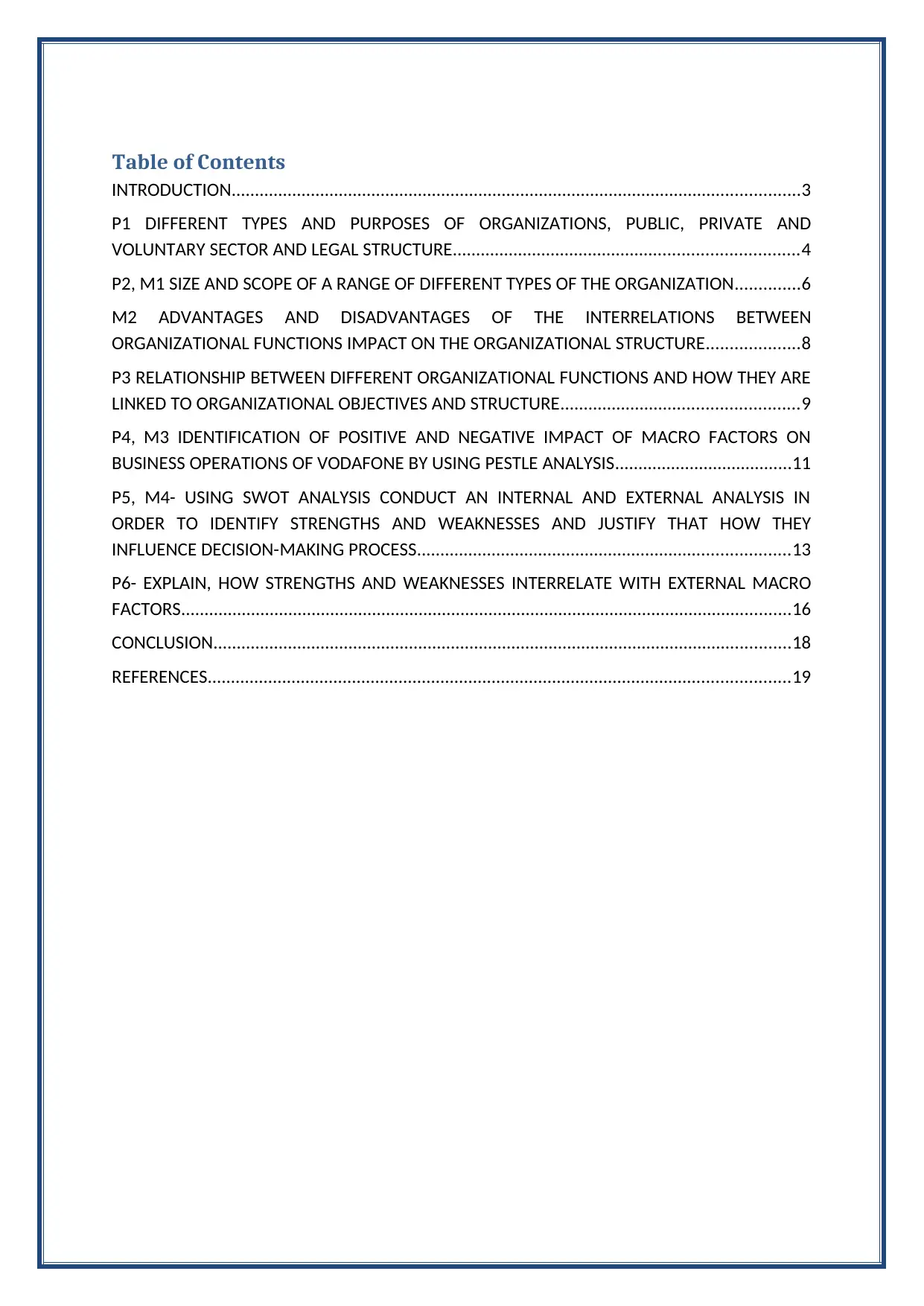
Table of Contents
INTRODUCTION..........................................................................................................................3
P1 DIFFERENT TYPES AND PURPOSES OF ORGANIZATIONS, PUBLIC, PRIVATE AND
VOLUNTARY SECTOR AND LEGAL STRUCTURE..........................................................................4
P2, M1 SIZE AND SCOPE OF A RANGE OF DIFFERENT TYPES OF THE ORGANIZATION..............6
M2 ADVANTAGES AND DISADVANTAGES OF THE INTERRELATIONS BETWEEN
ORGANIZATIONAL FUNCTIONS IMPACT ON THE ORGANIZATIONAL STRUCTURE....................8
P3 RELATIONSHIP BETWEEN DIFFERENT ORGANIZATIONAL FUNCTIONS AND HOW THEY ARE
LINKED TO ORGANIZATIONAL OBJECTIVES AND STRUCTURE...................................................9
P4, M3 IDENTIFICATION OF POSITIVE AND NEGATIVE IMPACT OF MACRO FACTORS ON
BUSINESS OPERATIONS OF VODAFONE BY USING PESTLE ANALYSIS......................................11
P5, M4- USING SWOT ANALYSIS CONDUCT AN INTERNAL AND EXTERNAL ANALYSIS IN
ORDER TO IDENTIFY STRENGTHS AND WEAKNESSES AND JUSTIFY THAT HOW THEY
INFLUENCE DECISION-MAKING PROCESS................................................................................13
P6- EXPLAIN, HOW STRENGTHS AND WEAKNESSES INTERRELATE WITH EXTERNAL MACRO
FACTORS...................................................................................................................................16
CONCLUSION............................................................................................................................18
REFERENCES.............................................................................................................................19
INTRODUCTION..........................................................................................................................3
P1 DIFFERENT TYPES AND PURPOSES OF ORGANIZATIONS, PUBLIC, PRIVATE AND
VOLUNTARY SECTOR AND LEGAL STRUCTURE..........................................................................4
P2, M1 SIZE AND SCOPE OF A RANGE OF DIFFERENT TYPES OF THE ORGANIZATION..............6
M2 ADVANTAGES AND DISADVANTAGES OF THE INTERRELATIONS BETWEEN
ORGANIZATIONAL FUNCTIONS IMPACT ON THE ORGANIZATIONAL STRUCTURE....................8
P3 RELATIONSHIP BETWEEN DIFFERENT ORGANIZATIONAL FUNCTIONS AND HOW THEY ARE
LINKED TO ORGANIZATIONAL OBJECTIVES AND STRUCTURE...................................................9
P4, M3 IDENTIFICATION OF POSITIVE AND NEGATIVE IMPACT OF MACRO FACTORS ON
BUSINESS OPERATIONS OF VODAFONE BY USING PESTLE ANALYSIS......................................11
P5, M4- USING SWOT ANALYSIS CONDUCT AN INTERNAL AND EXTERNAL ANALYSIS IN
ORDER TO IDENTIFY STRENGTHS AND WEAKNESSES AND JUSTIFY THAT HOW THEY
INFLUENCE DECISION-MAKING PROCESS................................................................................13
P6- EXPLAIN, HOW STRENGTHS AND WEAKNESSES INTERRELATE WITH EXTERNAL MACRO
FACTORS...................................................................................................................................16
CONCLUSION............................................................................................................................18
REFERENCES.............................................................................................................................19
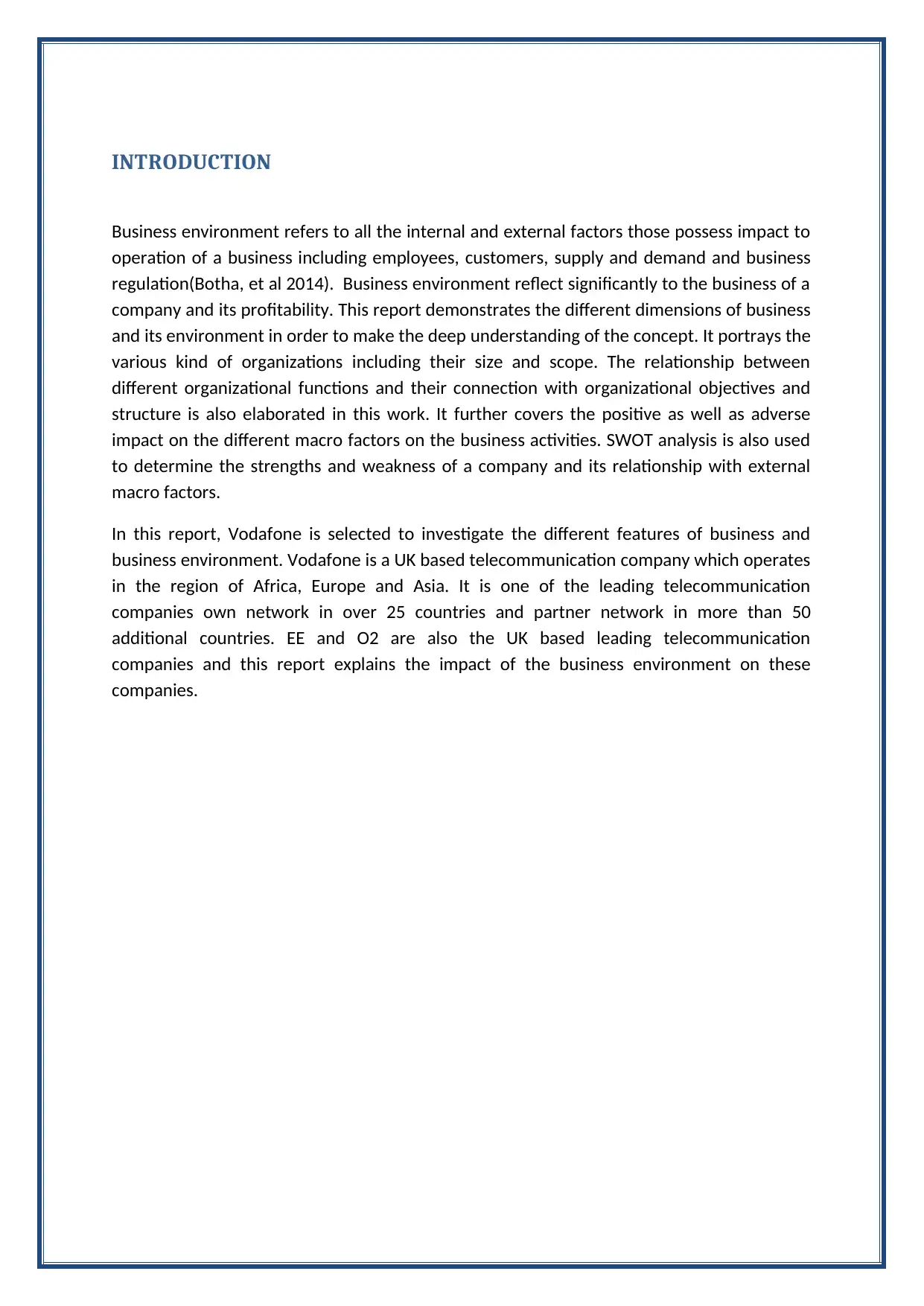
INTRODUCTION
Business environment refers to all the internal and external factors those possess impact to
operation of a business including employees, customers, supply and demand and business
regulation(Botha, et al 2014). Business environment reflect significantly to the business of a
company and its profitability. This report demonstrates the different dimensions of business
and its environment in order to make the deep understanding of the concept. It portrays the
various kind of organizations including their size and scope. The relationship between
different organizational functions and their connection with organizational objectives and
structure is also elaborated in this work. It further covers the positive as well as adverse
impact on the different macro factors on the business activities. SWOT analysis is also used
to determine the strengths and weakness of a company and its relationship with external
macro factors.
In this report, Vodafone is selected to investigate the different features of business and
business environment. Vodafone is a UK based telecommunication company which operates
in the region of Africa, Europe and Asia. It is one of the leading telecommunication
companies own network in over 25 countries and partner network in more than 50
additional countries. EE and O2 are also the UK based leading telecommunication
companies and this report explains the impact of the business environment on these
companies.
Business environment refers to all the internal and external factors those possess impact to
operation of a business including employees, customers, supply and demand and business
regulation(Botha, et al 2014). Business environment reflect significantly to the business of a
company and its profitability. This report demonstrates the different dimensions of business
and its environment in order to make the deep understanding of the concept. It portrays the
various kind of organizations including their size and scope. The relationship between
different organizational functions and their connection with organizational objectives and
structure is also elaborated in this work. It further covers the positive as well as adverse
impact on the different macro factors on the business activities. SWOT analysis is also used
to determine the strengths and weakness of a company and its relationship with external
macro factors.
In this report, Vodafone is selected to investigate the different features of business and
business environment. Vodafone is a UK based telecommunication company which operates
in the region of Africa, Europe and Asia. It is one of the leading telecommunication
companies own network in over 25 countries and partner network in more than 50
additional countries. EE and O2 are also the UK based leading telecommunication
companies and this report explains the impact of the business environment on these
companies.
⊘ This is a preview!⊘
Do you want full access?
Subscribe today to unlock all pages.

Trusted by 1+ million students worldwide
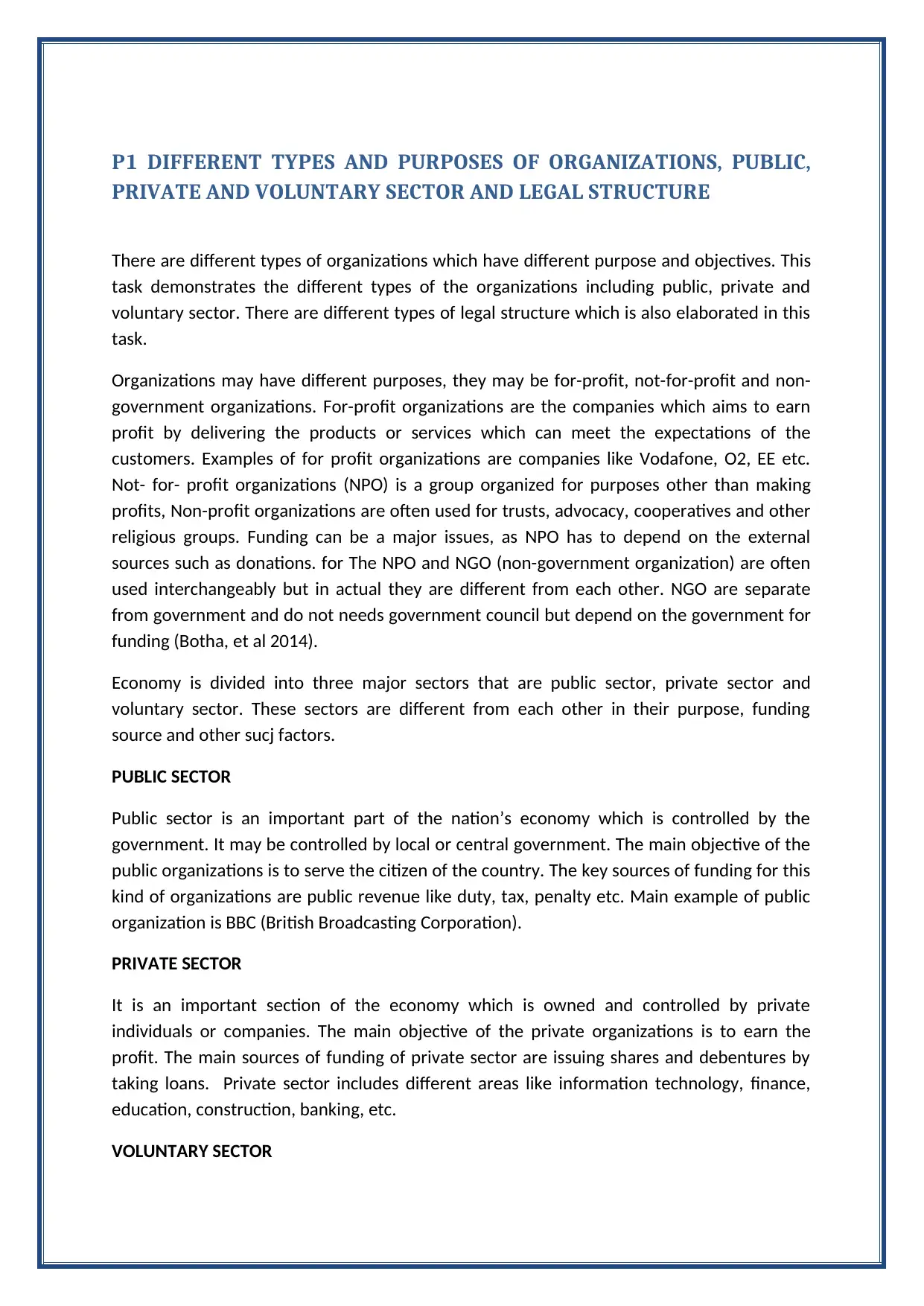
P1 DIFFERENT TYPES AND PURPOSES OF ORGANIZATIONS, PUBLIC,
PRIVATE AND VOLUNTARY SECTOR AND LEGAL STRUCTURE
There are different types of organizations which have different purpose and objectives. This
task demonstrates the different types of the organizations including public, private and
voluntary sector. There are different types of legal structure which is also elaborated in this
task.
Organizations may have different purposes, they may be for-profit, not-for-profit and non-
government organizations. For-profit organizations are the companies which aims to earn
profit by delivering the products or services which can meet the expectations of the
customers. Examples of for profit organizations are companies like Vodafone, O2, EE etc.
Not- for- profit organizations (NPO) is a group organized for purposes other than making
profits, Non-profit organizations are often used for trusts, advocacy, cooperatives and other
religious groups. Funding can be a major issues, as NPO has to depend on the external
sources such as donations. for The NPO and NGO (non-government organization) are often
used interchangeably but in actual they are different from each other. NGO are separate
from government and do not needs government council but depend on the government for
funding (Botha, et al 2014).
Economy is divided into three major sectors that are public sector, private sector and
voluntary sector. These sectors are different from each other in their purpose, funding
source and other sucj factors.
PUBLIC SECTOR
Public sector is an important part of the nation’s economy which is controlled by the
government. It may be controlled by local or central government. The main objective of the
public organizations is to serve the citizen of the country. The key sources of funding for this
kind of organizations are public revenue like duty, tax, penalty etc. Main example of public
organization is BBC (British Broadcasting Corporation).
PRIVATE SECTOR
It is an important section of the economy which is owned and controlled by private
individuals or companies. The main objective of the private organizations is to earn the
profit. The main sources of funding of private sector are issuing shares and debentures by
taking loans. Private sector includes different areas like information technology, finance,
education, construction, banking, etc.
VOLUNTARY SECTOR
PRIVATE AND VOLUNTARY SECTOR AND LEGAL STRUCTURE
There are different types of organizations which have different purpose and objectives. This
task demonstrates the different types of the organizations including public, private and
voluntary sector. There are different types of legal structure which is also elaborated in this
task.
Organizations may have different purposes, they may be for-profit, not-for-profit and non-
government organizations. For-profit organizations are the companies which aims to earn
profit by delivering the products or services which can meet the expectations of the
customers. Examples of for profit organizations are companies like Vodafone, O2, EE etc.
Not- for- profit organizations (NPO) is a group organized for purposes other than making
profits, Non-profit organizations are often used for trusts, advocacy, cooperatives and other
religious groups. Funding can be a major issues, as NPO has to depend on the external
sources such as donations. for The NPO and NGO (non-government organization) are often
used interchangeably but in actual they are different from each other. NGO are separate
from government and do not needs government council but depend on the government for
funding (Botha, et al 2014).
Economy is divided into three major sectors that are public sector, private sector and
voluntary sector. These sectors are different from each other in their purpose, funding
source and other sucj factors.
PUBLIC SECTOR
Public sector is an important part of the nation’s economy which is controlled by the
government. It may be controlled by local or central government. The main objective of the
public organizations is to serve the citizen of the country. The key sources of funding for this
kind of organizations are public revenue like duty, tax, penalty etc. Main example of public
organization is BBC (British Broadcasting Corporation).
PRIVATE SECTOR
It is an important section of the economy which is owned and controlled by private
individuals or companies. The main objective of the private organizations is to earn the
profit. The main sources of funding of private sector are issuing shares and debentures by
taking loans. Private sector includes different areas like information technology, finance,
education, construction, banking, etc.
VOLUNTARY SECTOR
Paraphrase This Document
Need a fresh take? Get an instant paraphrase of this document with our AI Paraphraser
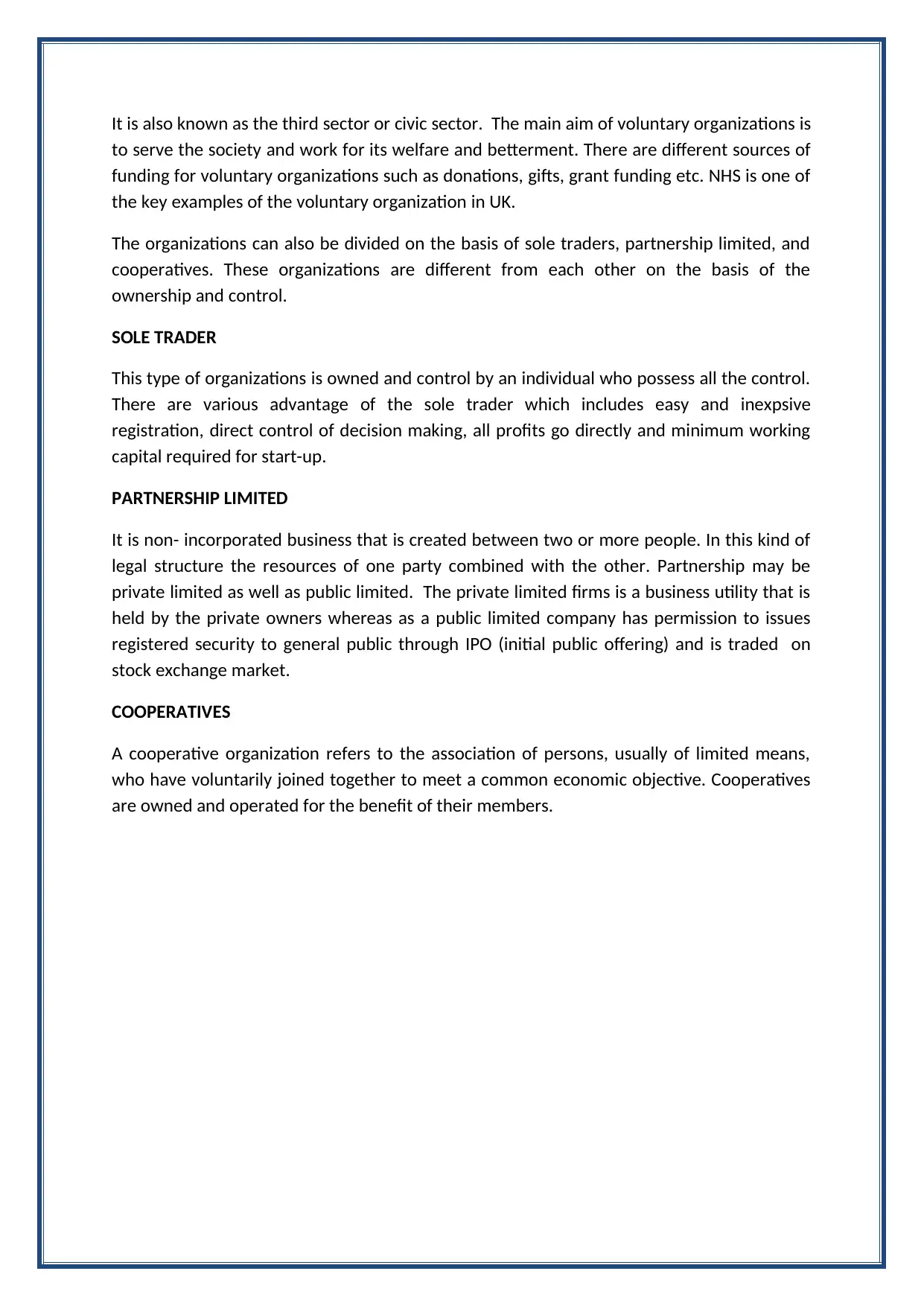
It is also known as the third sector or civic sector. The main aim of voluntary organizations is
to serve the society and work for its welfare and betterment. There are different sources of
funding for voluntary organizations such as donations, gifts, grant funding etc. NHS is one of
the key examples of the voluntary organization in UK.
The organizations can also be divided on the basis of sole traders, partnership limited, and
cooperatives. These organizations are different from each other on the basis of the
ownership and control.
SOLE TRADER
This type of organizations is owned and control by an individual who possess all the control.
There are various advantage of the sole trader which includes easy and inexpsive
registration, direct control of decision making, all profits go directly and minimum working
capital required for start-up.
PARTNERSHIP LIMITED
It is non- incorporated business that is created between two or more people. In this kind of
legal structure the resources of one party combined with the other. Partnership may be
private limited as well as public limited. The private limited firms is a business utility that is
held by the private owners whereas as a public limited company has permission to issues
registered security to general public through IPO (initial public offering) and is traded on
stock exchange market.
COOPERATIVES
A cooperative organization refers to the association of persons, usually of limited means,
who have voluntarily joined together to meet a common economic objective. Cooperatives
are owned and operated for the benefit of their members.
to serve the society and work for its welfare and betterment. There are different sources of
funding for voluntary organizations such as donations, gifts, grant funding etc. NHS is one of
the key examples of the voluntary organization in UK.
The organizations can also be divided on the basis of sole traders, partnership limited, and
cooperatives. These organizations are different from each other on the basis of the
ownership and control.
SOLE TRADER
This type of organizations is owned and control by an individual who possess all the control.
There are various advantage of the sole trader which includes easy and inexpsive
registration, direct control of decision making, all profits go directly and minimum working
capital required for start-up.
PARTNERSHIP LIMITED
It is non- incorporated business that is created between two or more people. In this kind of
legal structure the resources of one party combined with the other. Partnership may be
private limited as well as public limited. The private limited firms is a business utility that is
held by the private owners whereas as a public limited company has permission to issues
registered security to general public through IPO (initial public offering) and is traded on
stock exchange market.
COOPERATIVES
A cooperative organization refers to the association of persons, usually of limited means,
who have voluntarily joined together to meet a common economic objective. Cooperatives
are owned and operated for the benefit of their members.

P2, M1 SIZE AND SCOPE OF A RANGE OF DIFFERENT TYPES OF THE
ORGANIZATION
This task demonstrates the different types of the organization on the basis of size. It further
explains their scope of a range of the different types of the organizations.
The business organizations can classified into four different parts on the basis of micro,
small, medium and large. The objectives, number of employee, way of working, and
organizational structures of these organizations are different from each other.
MICRO ORGANIZATION
Micro organizations are the small companies or shops such as ice-cream parlour, café etc.
These companies operate with less than 10 people. The objective of these kind of the
organizations is to earn money to make the living. These kind of the organizations add value
to economy. It does not require large number of the employees or training as well as it can
be started with low financial resources.
SMALL ORGANIZATION
A small organization employs a small number of the employees and it does not requires any
specialized training. The number of the employees in this kind of organization can vary from
10 to 50 employees. The revenue generation of this kind of organization depends on the
kind of industry they are in. The objective of the small organizations is to enhance the
profitability of the company and to achieve significant growth.
MEDIUM ORGANIZATION
Medium size organizations are larger than the small organization and are smaller than the
large organizations. The number of the employees in medium size organization can reach to
250 employees. The medium size organization also aims to achieve the significant growth
and profitability.
LARGE ORGANIZATIONS
As the name indicates large organizations are larger in size as compared to medium
organization. Large organization requires large number of the employees and significant
amount of the financial resources to operate its business smoothly. The large organizations
focus on the achievement of the considerable market share and profitability.
Apart from these organizations there is one other kind of organization which reflects
significantly to the economy and that is transnational corporation. A transnational
ORGANIZATION
This task demonstrates the different types of the organization on the basis of size. It further
explains their scope of a range of the different types of the organizations.
The business organizations can classified into four different parts on the basis of micro,
small, medium and large. The objectives, number of employee, way of working, and
organizational structures of these organizations are different from each other.
MICRO ORGANIZATION
Micro organizations are the small companies or shops such as ice-cream parlour, café etc.
These companies operate with less than 10 people. The objective of these kind of the
organizations is to earn money to make the living. These kind of the organizations add value
to economy. It does not require large number of the employees or training as well as it can
be started with low financial resources.
SMALL ORGANIZATION
A small organization employs a small number of the employees and it does not requires any
specialized training. The number of the employees in this kind of organization can vary from
10 to 50 employees. The revenue generation of this kind of organization depends on the
kind of industry they are in. The objective of the small organizations is to enhance the
profitability of the company and to achieve significant growth.
MEDIUM ORGANIZATION
Medium size organizations are larger than the small organization and are smaller than the
large organizations. The number of the employees in medium size organization can reach to
250 employees. The medium size organization also aims to achieve the significant growth
and profitability.
LARGE ORGANIZATIONS
As the name indicates large organizations are larger in size as compared to medium
organization. Large organization requires large number of the employees and significant
amount of the financial resources to operate its business smoothly. The large organizations
focus on the achievement of the considerable market share and profitability.
Apart from these organizations there is one other kind of organization which reflects
significantly to the economy and that is transnational corporation. A transnational
⊘ This is a preview!⊘
Do you want full access?
Subscribe today to unlock all pages.

Trusted by 1+ million students worldwide
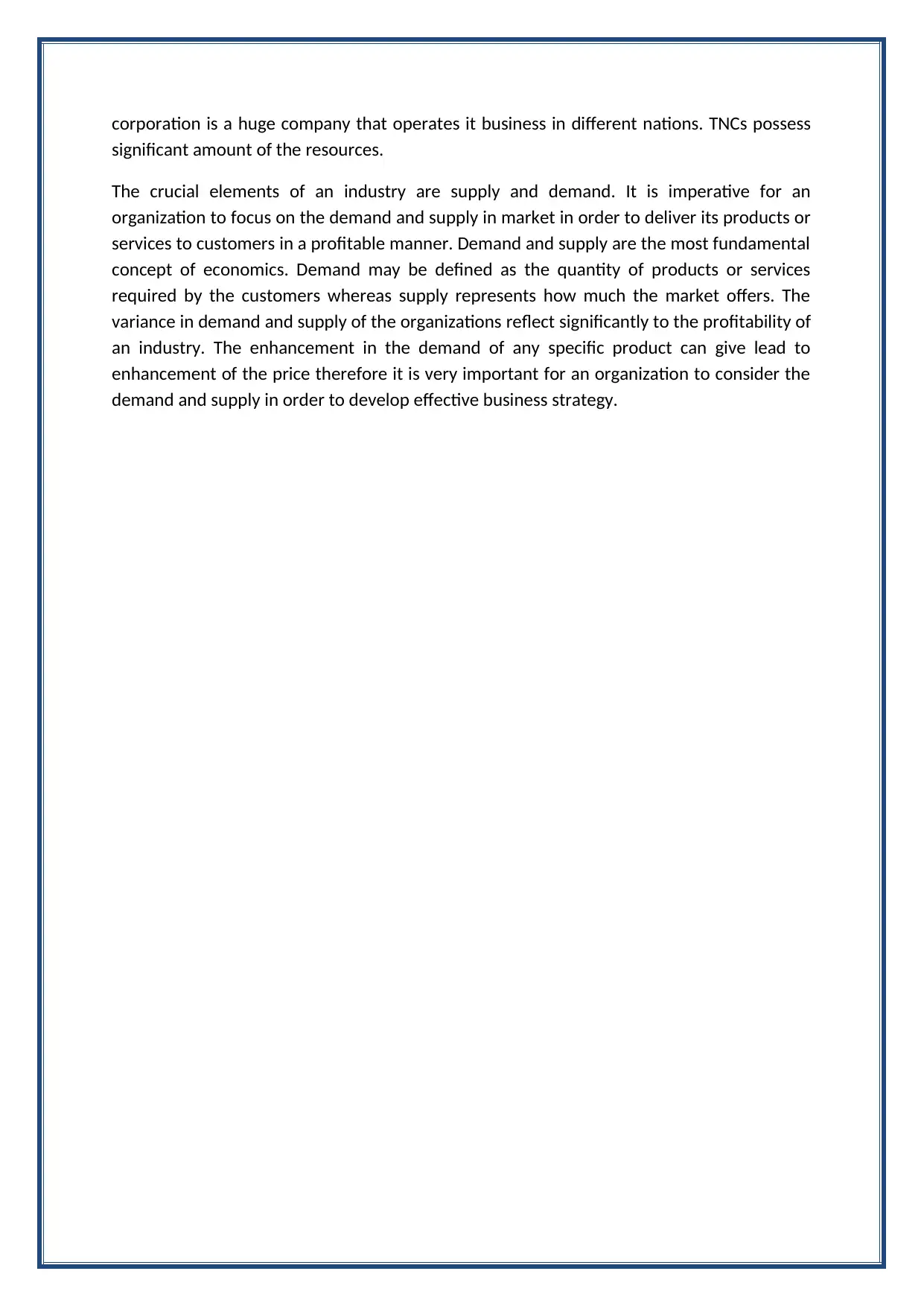
corporation is a huge company that operates it business in different nations. TNCs possess
significant amount of the resources.
The crucial elements of an industry are supply and demand. It is imperative for an
organization to focus on the demand and supply in market in order to deliver its products or
services to customers in a profitable manner. Demand and supply are the most fundamental
concept of economics. Demand may be defined as the quantity of products or services
required by the customers whereas supply represents how much the market offers. The
variance in demand and supply of the organizations reflect significantly to the profitability of
an industry. The enhancement in the demand of any specific product can give lead to
enhancement of the price therefore it is very important for an organization to consider the
demand and supply in order to develop effective business strategy.
significant amount of the resources.
The crucial elements of an industry are supply and demand. It is imperative for an
organization to focus on the demand and supply in market in order to deliver its products or
services to customers in a profitable manner. Demand and supply are the most fundamental
concept of economics. Demand may be defined as the quantity of products or services
required by the customers whereas supply represents how much the market offers. The
variance in demand and supply of the organizations reflect significantly to the profitability of
an industry. The enhancement in the demand of any specific product can give lead to
enhancement of the price therefore it is very important for an organization to consider the
demand and supply in order to develop effective business strategy.
Paraphrase This Document
Need a fresh take? Get an instant paraphrase of this document with our AI Paraphraser

M2 ADVANTAGES AND DISADVANTAGES OF THE INTERRELATIONS
BETWEEN ORGANIZATIONAL FUNCTIONS IMPACT ON THE
ORGANIZATIONAL STRUCTURE
There are different advantages and disadvantages of the interrelationship between
organizational functions therefore it is important for the company to develop effective
strategies to make the interrelationship more advantageous.
The advantage of the interrelationship of organizational functions are:
Effective communication
Enhancement in efficiency and productivity
Development of healthy environment
One of the main advantages of the interrelationship between different organizational
functions is that its promotes communication between organizational functions. The
effective communication between the employees belong to different organization help
them in avoiding and solving problems. Enhancement in the efficiency and productivity of
the different organisational functions is one of the other advantage of their
interrelationship. A healthy interrelationship between different organizational functions
helps an organisation in developing and maintains a healthy environment at workplace.
Disadvantages of the interrelationship between different organizational functions are;
Misunderstanding
Conflict of interest
The employees belong to different department belong to different educational background
which can influence their mutual understanding. The background difference can lead to
misunderstanding. The conflict of interest is also one of the major factor which can give rise
different issues.
BETWEEN ORGANIZATIONAL FUNCTIONS IMPACT ON THE
ORGANIZATIONAL STRUCTURE
There are different advantages and disadvantages of the interrelationship between
organizational functions therefore it is important for the company to develop effective
strategies to make the interrelationship more advantageous.
The advantage of the interrelationship of organizational functions are:
Effective communication
Enhancement in efficiency and productivity
Development of healthy environment
One of the main advantages of the interrelationship between different organizational
functions is that its promotes communication between organizational functions. The
effective communication between the employees belong to different organization help
them in avoiding and solving problems. Enhancement in the efficiency and productivity of
the different organisational functions is one of the other advantage of their
interrelationship. A healthy interrelationship between different organizational functions
helps an organisation in developing and maintains a healthy environment at workplace.
Disadvantages of the interrelationship between different organizational functions are;
Misunderstanding
Conflict of interest
The employees belong to different department belong to different educational background
which can influence their mutual understanding. The background difference can lead to
misunderstanding. The conflict of interest is also one of the major factor which can give rise
different issues.

P3 RELATIONSHIP BETWEEN DIFFERENT ORGANIZATIONAL
FUNCTIONS AND HOW THEY ARE LINKED TO ORGANIZATIONAL
OBJECTIVES AND STRUCTURE
This task covers the different organizational functions and their relationship with each
other. It also elaborates their role in achieving different business objectives. The relationship
between different organizational functions and organizational objectives and structure is
also described in this topic.
There are various kind of the organizational functions which coordinate with each other in
order to achieve common objectives. In Vodafone also there are various departments which
coordinate and cooperate with each other in order to achieve the common objectives. The
key organizational functions are marketing, human resource management, finance and
operation. All these functions play an important role in the smooth of various organizational
activities of Vodafone.
MARKETING
Marketing is a crucial department of an organization which play an important role in
enhancing the profitability of the company. The key role of the marketing department in
Vodafone is to conduct the market research and to identify the different needs and demand
of the customers. It also develops the effective strategies for enhancing the brand
awareness in order to enhance the market share and profitability.
HUMAN RESOURCE MANAGEMENT
Human resource management concerns with the recruitment of the employees with
required skills and knowledge. It is responsibility of this department is to provide effective
training of the employees so that they perform their assignment roles and responsibilities in
an effective manner. The HR department of the Vodafone hires the talented and skilled
employees and motivate them to deliver better performance.
FINANCE
The responsibility of Finance department of an organization includes financial planning,
reporting and controlling investment, internal risk management, hedging merger and
acquisitions, cash management and corporate finance, auditing and accounting. The
financial department of Vodafone develops the effective financial plan in order to achieve
the financial improvement.
OPERATIONS
FUNCTIONS AND HOW THEY ARE LINKED TO ORGANIZATIONAL
OBJECTIVES AND STRUCTURE
This task covers the different organizational functions and their relationship with each
other. It also elaborates their role in achieving different business objectives. The relationship
between different organizational functions and organizational objectives and structure is
also described in this topic.
There are various kind of the organizational functions which coordinate with each other in
order to achieve common objectives. In Vodafone also there are various departments which
coordinate and cooperate with each other in order to achieve the common objectives. The
key organizational functions are marketing, human resource management, finance and
operation. All these functions play an important role in the smooth of various organizational
activities of Vodafone.
MARKETING
Marketing is a crucial department of an organization which play an important role in
enhancing the profitability of the company. The key role of the marketing department in
Vodafone is to conduct the market research and to identify the different needs and demand
of the customers. It also develops the effective strategies for enhancing the brand
awareness in order to enhance the market share and profitability.
HUMAN RESOURCE MANAGEMENT
Human resource management concerns with the recruitment of the employees with
required skills and knowledge. It is responsibility of this department is to provide effective
training of the employees so that they perform their assignment roles and responsibilities in
an effective manner. The HR department of the Vodafone hires the talented and skilled
employees and motivate them to deliver better performance.
FINANCE
The responsibility of Finance department of an organization includes financial planning,
reporting and controlling investment, internal risk management, hedging merger and
acquisitions, cash management and corporate finance, auditing and accounting. The
financial department of Vodafone develops the effective financial plan in order to achieve
the financial improvement.
OPERATIONS
⊘ This is a preview!⊘
Do you want full access?
Subscribe today to unlock all pages.

Trusted by 1+ million students worldwide

It is an important organizational department which deals in manufacturing of the products
or service. The responsibility of operation department is to develop the products of services
which can meet the expectations of the customers.
All the above mentioned organizational functions are interrelated with each other. Effective
coordination and cooperation between these organizational functions is one of the
important factors responsible for the smooth operations of different organizational
activities in Vodafone. For example, the marketing department of Vodafone conduct market
research in order to understand the demand of the market and guide the operations
department to develop the products or services which can meet the expectation of the
customers. These organizational works as team in order to achieve different organizational
objectives such as survival, increasing sales, maximizing profits, satisfying customers and
growth. All these departments play an important coordinate with each other to achieve the
common goals that is growth of the organizations.
The organizational functions are also linked with the different organizational structure. An
organizational structure defined as the framework in which an organization outlines the
different responsibilities in their firm. There are four type of organizational structure which
includes function based, geography based, product based and customer structure based
organizational structure.
Function based organization – It is most common organizational structure in which the
organization is divided into different groups based on specialized areas such as finance,
marketing HR etc.
Geography based - Geography based organizational structure is used by the companies
which have business units in different geographic locations.
Product based – It is an organizational structure in which activities are grouped according to
service or products.
Customer based structure – The organizations adapt this kind of the structure in an effort to
ensure specific customer needs are met by a customized service approach.
The organizational functions and organizational structure of the Vodafone are interrelated
with each other. Vodafone adopt the above mentioned structure so that its organizational
structure can perform their assigned roles and responsibilities in an effective manner. It help
company in improving the communication system and enhancing the efficiency and
productivity of the employees.
or service. The responsibility of operation department is to develop the products of services
which can meet the expectations of the customers.
All the above mentioned organizational functions are interrelated with each other. Effective
coordination and cooperation between these organizational functions is one of the
important factors responsible for the smooth operations of different organizational
activities in Vodafone. For example, the marketing department of Vodafone conduct market
research in order to understand the demand of the market and guide the operations
department to develop the products or services which can meet the expectation of the
customers. These organizational works as team in order to achieve different organizational
objectives such as survival, increasing sales, maximizing profits, satisfying customers and
growth. All these departments play an important coordinate with each other to achieve the
common goals that is growth of the organizations.
The organizational functions are also linked with the different organizational structure. An
organizational structure defined as the framework in which an organization outlines the
different responsibilities in their firm. There are four type of organizational structure which
includes function based, geography based, product based and customer structure based
organizational structure.
Function based organization – It is most common organizational structure in which the
organization is divided into different groups based on specialized areas such as finance,
marketing HR etc.
Geography based - Geography based organizational structure is used by the companies
which have business units in different geographic locations.
Product based – It is an organizational structure in which activities are grouped according to
service or products.
Customer based structure – The organizations adapt this kind of the structure in an effort to
ensure specific customer needs are met by a customized service approach.
The organizational functions and organizational structure of the Vodafone are interrelated
with each other. Vodafone adopt the above mentioned structure so that its organizational
structure can perform their assigned roles and responsibilities in an effective manner. It help
company in improving the communication system and enhancing the efficiency and
productivity of the employees.
Paraphrase This Document
Need a fresh take? Get an instant paraphrase of this document with our AI Paraphraser
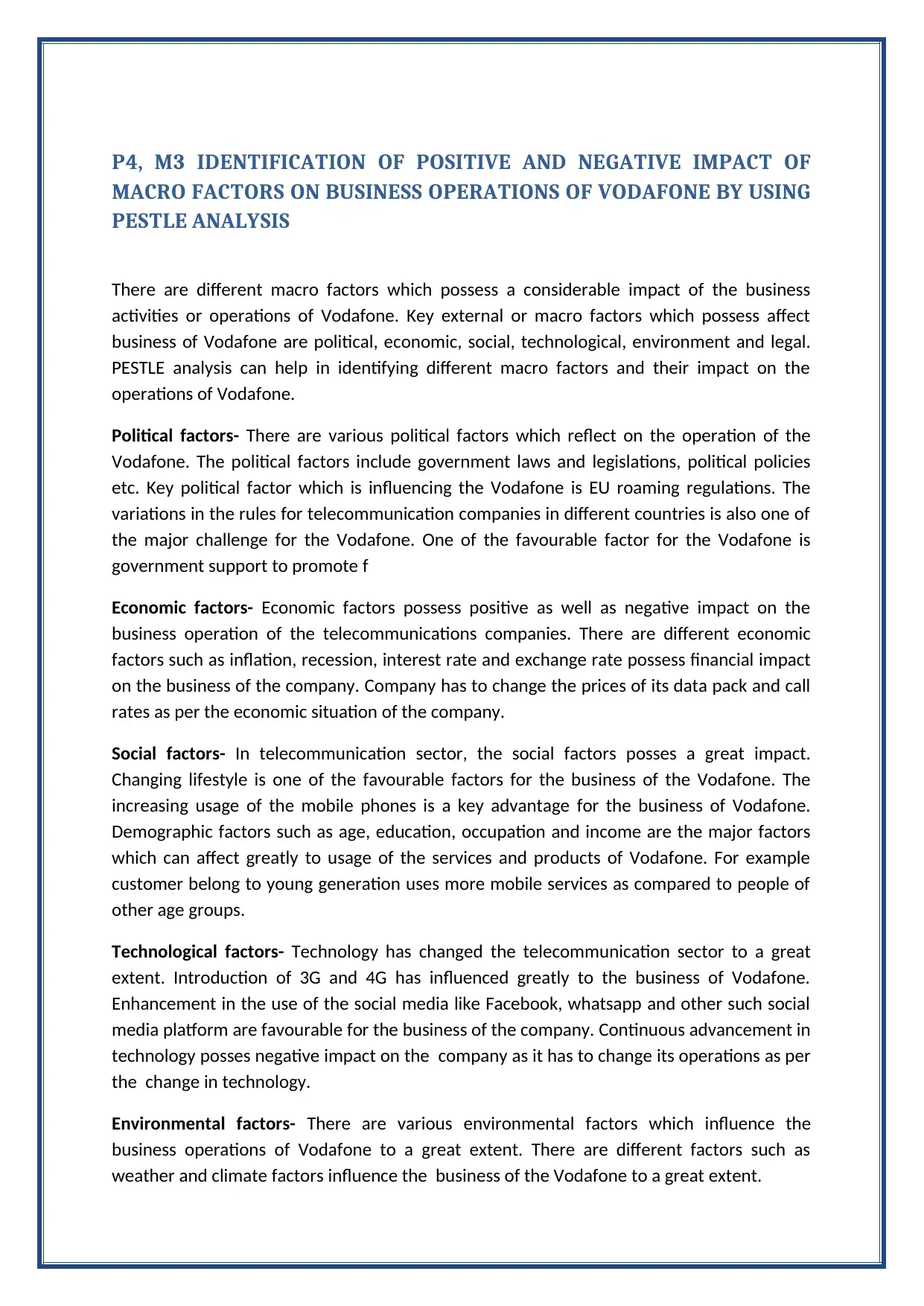
P4, M3 IDENTIFICATION OF POSITIVE AND NEGATIVE IMPACT OF
MACRO FACTORS ON BUSINESS OPERATIONS OF VODAFONE BY USING
PESTLE ANALYSIS
There are different macro factors which possess a considerable impact of the business
activities or operations of Vodafone. Key external or macro factors which possess affect
business of Vodafone are political, economic, social, technological, environment and legal.
PESTLE analysis can help in identifying different macro factors and their impact on the
operations of Vodafone.
Political factors- There are various political factors which reflect on the operation of the
Vodafone. The political factors include government laws and legislations, political policies
etc. Key political factor which is influencing the Vodafone is EU roaming regulations. The
variations in the rules for telecommunication companies in different countries is also one of
the major challenge for the Vodafone. One of the favourable factor for the Vodafone is
government support to promote f
Economic factors- Economic factors possess positive as well as negative impact on the
business operation of the telecommunications companies. There are different economic
factors such as inflation, recession, interest rate and exchange rate possess financial impact
on the business of the company. Company has to change the prices of its data pack and call
rates as per the economic situation of the company.
Social factors- In telecommunication sector, the social factors posses a great impact.
Changing lifestyle is one of the favourable factors for the business of the Vodafone. The
increasing usage of the mobile phones is a key advantage for the business of Vodafone.
Demographic factors such as age, education, occupation and income are the major factors
which can affect greatly to usage of the services and products of Vodafone. For example
customer belong to young generation uses more mobile services as compared to people of
other age groups.
Technological factors- Technology has changed the telecommunication sector to a great
extent. Introduction of 3G and 4G has influenced greatly to the business of Vodafone.
Enhancement in the use of the social media like Facebook, whatsapp and other such social
media platform are favourable for the business of the company. Continuous advancement in
technology posses negative impact on the company as it has to change its operations as per
the change in technology.
Environmental factors- There are various environmental factors which influence the
business operations of Vodafone to a great extent. There are different factors such as
weather and climate factors influence the business of the Vodafone to a great extent.
MACRO FACTORS ON BUSINESS OPERATIONS OF VODAFONE BY USING
PESTLE ANALYSIS
There are different macro factors which possess a considerable impact of the business
activities or operations of Vodafone. Key external or macro factors which possess affect
business of Vodafone are political, economic, social, technological, environment and legal.
PESTLE analysis can help in identifying different macro factors and their impact on the
operations of Vodafone.
Political factors- There are various political factors which reflect on the operation of the
Vodafone. The political factors include government laws and legislations, political policies
etc. Key political factor which is influencing the Vodafone is EU roaming regulations. The
variations in the rules for telecommunication companies in different countries is also one of
the major challenge for the Vodafone. One of the favourable factor for the Vodafone is
government support to promote f
Economic factors- Economic factors possess positive as well as negative impact on the
business operation of the telecommunications companies. There are different economic
factors such as inflation, recession, interest rate and exchange rate possess financial impact
on the business of the company. Company has to change the prices of its data pack and call
rates as per the economic situation of the company.
Social factors- In telecommunication sector, the social factors posses a great impact.
Changing lifestyle is one of the favourable factors for the business of the Vodafone. The
increasing usage of the mobile phones is a key advantage for the business of Vodafone.
Demographic factors such as age, education, occupation and income are the major factors
which can affect greatly to usage of the services and products of Vodafone. For example
customer belong to young generation uses more mobile services as compared to people of
other age groups.
Technological factors- Technology has changed the telecommunication sector to a great
extent. Introduction of 3G and 4G has influenced greatly to the business of Vodafone.
Enhancement in the use of the social media like Facebook, whatsapp and other such social
media platform are favourable for the business of the company. Continuous advancement in
technology posses negative impact on the company as it has to change its operations as per
the change in technology.
Environmental factors- There are various environmental factors which influence the
business operations of Vodafone to a great extent. There are different factors such as
weather and climate factors influence the business of the Vodafone to a great extent.

Legal factors- Legal laws and legislations influence the business operations of the
organizations. The difference in laws and legislations of the different countries influence the
business operations as company has to follow all the regulations of the company.
It is important for Vodafone to develop effective strategies to respond the changes caused
by the macro factors. Company need to focus on each and every factor to make significant
growth.
organizations. The difference in laws and legislations of the different countries influence the
business operations as company has to follow all the regulations of the company.
It is important for Vodafone to develop effective strategies to respond the changes caused
by the macro factors. Company need to focus on each and every factor to make significant
growth.
⊘ This is a preview!⊘
Do you want full access?
Subscribe today to unlock all pages.

Trusted by 1+ million students worldwide
1 out of 21
Related Documents
Your All-in-One AI-Powered Toolkit for Academic Success.
+13062052269
info@desklib.com
Available 24*7 on WhatsApp / Email
![[object Object]](/_next/static/media/star-bottom.7253800d.svg)
Unlock your academic potential
Copyright © 2020–2025 A2Z Services. All Rights Reserved. Developed and managed by ZUCOL.





